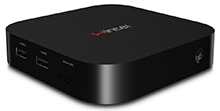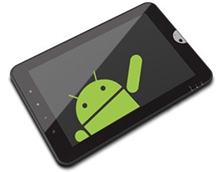
There are many tablets on the market which are both affordable and accessible. You can get a non-big-brand 7” tablet for under $100 and a 10” for about $150, while there are higher performing models with more storage priced around $250.
Most budget-priced tablets are likely to run one of two operating systems – Google Android or Microsoft Windows. In addition, there are also Windows mini-PCs that can be used as a desktop computer. This section provides you with some options for the minimum specification you will need and where they can be purchased.
Android or Windows?
The first decision you will need to make is whether you want to purchase a tablet running Google Android or Microsoft Windows. There are a number of benefits depending on your needs, and you can find more detail in the What’s suitable? section.
Let’s look at the benefits and the potential drawbacks of both platforms, starting with the Google Android system.
Android
| Benefits | Issues |
|---|---|
| App library: The operating system has been around for some time and its app library is quite comprehensive. | No desktop: Users familiar with the Windows desktop where you use a keyboard and a mouse to do most things may find the commands in Android difficult. |
| Lightweight: Android tablets generally run processors similar to those found in smartphones, and as such are generally quite light and portable.; | Limited Office software: While Microsoft Office and other Office-style programs similar to Word and PowerPoint are available, it is not easy to purchase them and set up the software in a similar way to a Windows system. |
| Easier to use: Unlike a fully-featured desktop operating system, Android is designed to be simple for doing quick things so it may be easier to use than a full-sized system like Windows, especially when you’re commuting or travelling. | Storage: Generally Android tablets will have much less storage space than a Windows computer, relying more on storing things on the cloud which may be difficult for some users. |
| Google apps: Most Android tablets come built-in with a number of really convenient apps such as maps, Gmail, music and video software so if you like the way Google do things, an Android tablet is likely to be beneficial. | Battery: Cheaper Android tablets typically tend to have a small battery which may only last a few hours and this may not be enough time for your everyday use. |
| Difficult to upgrade: Android tablets, particularly lesser-known brands, are often difficult to upgrade. |
Now let’s look at the upsides and downsides of the Windows operating system.
Windows
| Benefits | Issues |
|---|---|
| Tablet can also be a desktop: Windows tablets can generally be used as a desktop PC by connecting a mouse and keyboard via USB or Bluetooth, meaning that you can use the device as both a tablet when you’re going somewhere or a desktop when using it at home. | Fewer tablet-based apps: While the range of desktop software for Windows is large, the Windows Store is still relatively small, meaning there’s not as many apps that make use of the touch-screen as there are in Android. |
| Upgradeable: Most Windows 8.x-based tablets can be freely upgraded to Windows 10, providing you with additional accessibility features. | Storage: While Windows tablets generally have more space than Android tablets, most of this space is taken up by Windows leaving little room for installing new programs unless extra storage such as an SD card is added. |
| Office: Many Windows tablets come with a free 1-year subscription to Office 365 meaning that you can use applications like Word and Excel straightaway. | Speed: While Windows tablets generally have better hardware than an Android tablet, they are often considered slow by Windows standards so a cheap Windows tablet may not run as quickly as a desktop PC. |
| Better hardware: Generally Windows tablets will come with a faster processor, more memory and more storage due to it needing to run a full-desktop operating system. | |
| Install Windows software: Windows-based tablets work like PCs and as such you can install other Windows-based software on them. | |
| Install assistive technology software: As a Windows tablet contains a full version of the OS, it is possible to install other assistive technology software programs such as NVDA. |
 Choosing an Android tablet
Choosing an Android tablet
If you’ve decided to get an Android tablet, there’s a wide range of choices with sizes ranging from 7” to 10” screens. Below you’ll find some recommended questions and a list of specifications to maximise the usefulness of your new device. For example, a tablet described as “7 inch quad-core Android 5.0 8GB” would describe a tablet with a 7 inch screen that meets the recommended specification.
Android tablet q&a
| Question | Answer |
|---|---|
| How many cores does the processor have? | Processor: quad-core or higher recommended, dual-core minimum. |
| How much RAM is available? | RAM: 1GB or higher |
| How much storage is available? | Storage space: 8GB or higher recommended, 4GB minimum. |
| Does it have an SD card slot? | Yes, the tablet should have an SD card slot. |
| What version of Android does it run? | Android 5.0 Lollipop or later is recommended, 4.4 KitKat minimum. Additional information on the accessibility features in different versions of Android can be found at What’s accessible |
 Choosing a Windows tablet
Choosing a Windows tablet
If you’re after a Windows tablet, it’s important to think about the screen size and configuration that will work best for your needs and your budget. Check out the recommended questions and a list of specifications that will do the job.
Windows tablet q&a
| Question | Answer |
|---|---|
| How much RAM is available? | RAM: 2GB or higher |
| How much storage is available? | Storage: 32GB or higher recommended, 16GB minimum. |
| Does it have an SD card slot? | Yes, the tablet should have an SD card slot. |
| What version of Windows does it run? If it’s not Windows 10, can it be upgraded to Windows 10 for free? | Operating system: Windows 8.1 or Windows 10. If it is running Windows 8.1, confirm with the retailer that the tablet is entitled to the free Windows 10 upgrade. |
| Does it come with a 1-year Office 365 subscription? | The tablet should come with a subscription to Office 365 so that you can use programs like Word and Excel. |
| Does it have an HDMI or monitor connection? | HDMI: tablet should come with an HDMI, micro-HDMI or display port if you want to connect the tablet to a monitor like a desktop PC. |
Pricing and purchasing
There are many popular retailers and online stores that sell tablet computers all across Australia, so invest some time in looking around, once you have decided what type of tablet you want.
Prices for Android tablets start at around $60 for minimum requirements with a recommended specification available for approximately $100. Android tablets with more recognised brands start at around $150. The full range of tablets can be found by searching online retailers for the keywords ‘android tablet’.
Windows tablets start at approximately $150. Windows tablets with a recognised brand name generally start from $200. Windows tablets can be found in online stores using the keyword search ‘windows tablet’.
While there’s no particular brand or tablet that stands out in this price range for Android tablets, the Hewlett-Packard Stream models are good examples of brand-name Windows tablets where some models can be found for about $200.
Retailers that stock cheap tablets include:
There is also a large selection available on auction websites such as eBay.
Pricing for Android:
From $60 – for a non-brand Android tablet with minimum specifications.
From $100 – for a non-brand Android with recommended specifications.
From $150 – for a recognised brand-name Android with recommended specs.
Pricing for Windows:
From $150 – for a Windows tablet with minimum specifications.
From $200 – for a Windows tablet with recommended specs.
Purchasing a cheap mini-desktop computer
In addition to Android and Windows tablets, you can also find cheap Android and Windows mini-desktop computers, mainly through online retailers and auction websites such as eBay.
 These computers are often referred to as a ‘TV box’ or ‘PC-on-a-stick’ and are generally a small box with some USB ports, an HDMI port for connecting to a monitor and possibly an SD card slot. Their hardware is often similar to the tablets, just without a screen.
These computers are often referred to as a ‘TV box’ or ‘PC-on-a-stick’ and are generally a small box with some USB ports, an HDMI port for connecting to a monitor and possibly an SD card slot. Their hardware is often similar to the tablets, just without a screen.
The Windows ‘TV box’ can work as a simple desktop computer, with mouse and keyboard being able to connect through the USB ports or Bluetooth, and the monitor connected through HDMI. The ‘stick’ version looks similar ot a USB stick but is a full desktop computer. An example of this is the Intel compute Stick.
Android-based TV boxes are also available, but are generally less useful as the operating system and apps rely heavily on a touchscreen, which is a feature that is likely to be unavailable if connected to a standard monitor or television. Yet some models do offer a remote control or additional pointing device to help rectify the situation.
The benefits and issues for Android and Windows tablets are similar for TV boxes, so similar considerations should be made if purchasing one. Prices for an Android TV box start at about the $50 mark, while Windows TV boxes start at around $140. The Intel Compute Stick is priced around $200.
Be aware that while these products are often listed on Australian auction websites, they are often sourced from overseas. For more information on the benefits and risks of purchasing products from overseas, refer to What’s possible?.
Pricing:
From $50 – for an Android TV box.
From $140 – for a Windows TV box.
